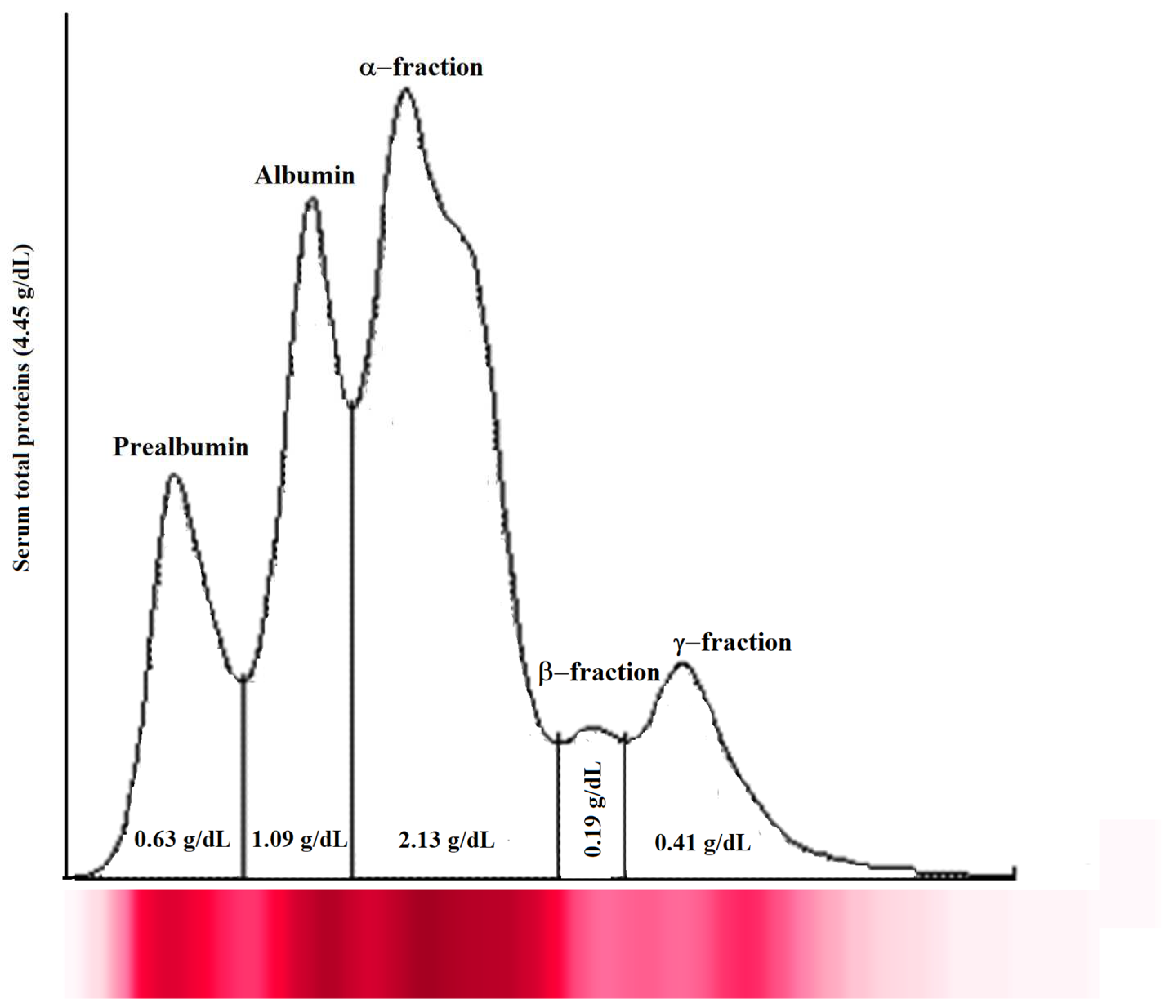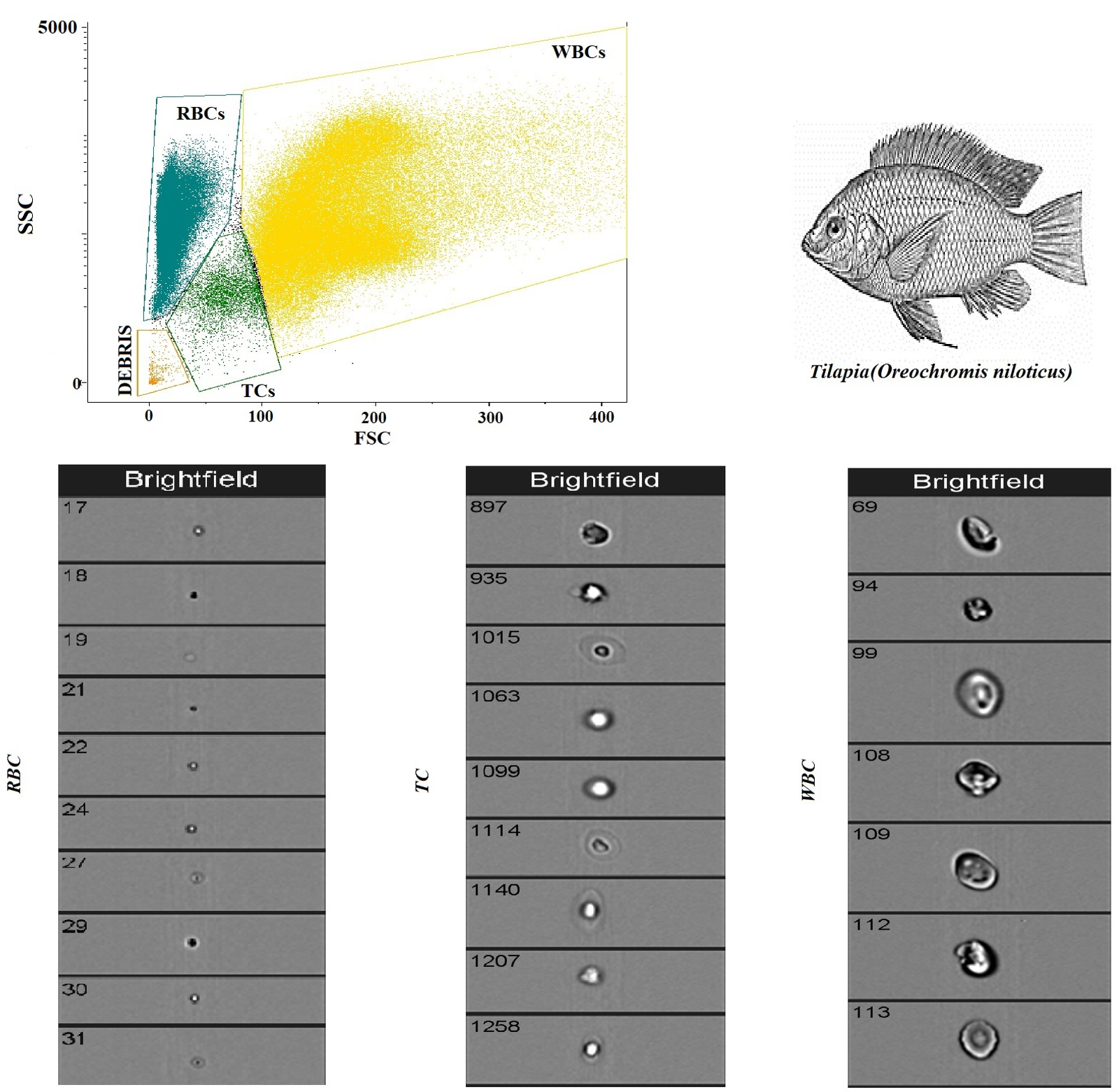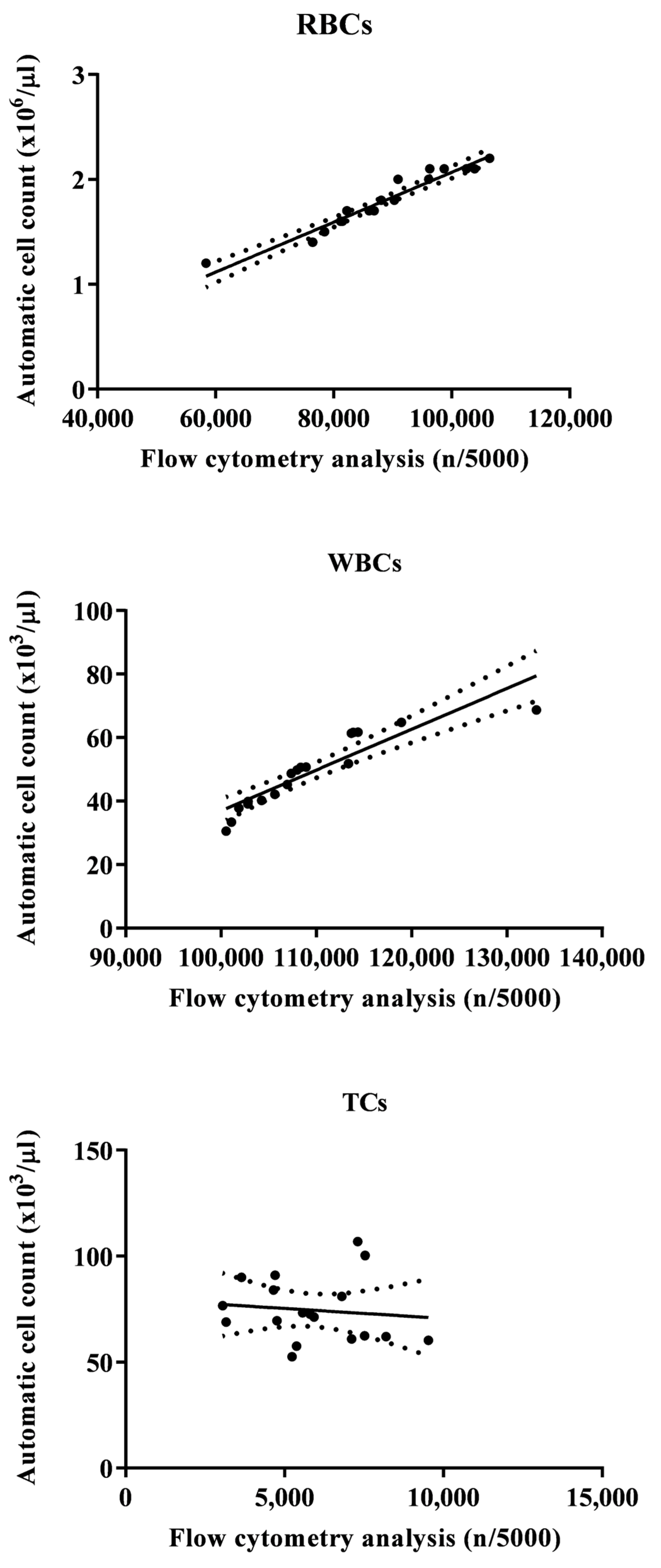Automated Hematological Approach and Protein Electrophoretic Pattern in Tilapia (Oreochromis niloticus): An Innovative and Experimental Model for Aquaculture
Abstract
Simple Summary
Abstract
1. Introduction
2. Materials and Methods
2.1. Animals
2.2. Blood Sampling
2.3. Automated Blood Count Test
2.4. Flow Cytometer Test
2.5. Serum Total Proteins and Their Fractions Analysis
2.6. Statistical Analysis
3. Results
3.1. Serum Protein
3.2. Hematological Analysis
4. Discussion
5. Conclusions
Author Contributions
Funding
Institutional Review Board Statement
Informed Consent Statement
Data Availability Statement
Conflicts of Interest
References
- Tavares-Dias, M.; Ruas de Moraes, F. Hematological parameters for the Brycon orbignyanus Valenciennes, 1850 (Osteichthyes, Characidae) intensively bred. Hidrobiology 2006, 16, 271–274. [Google Scholar]
- Fazio, F.; Faggio, C.; Marafoti, S.; Torre, A.; Sanflippo, M.; Piccione, G. Effect of water quality on hematological and biochemical parameters of Gobius niger caught in Faro lake (Sicily). Iran. J. Fish. Sci. 2013, 12, 219–231. [Google Scholar]
- Różyński, M.; Demska-Zakęs, K.; Sikora, A.; Zakęs, Z. Impact of inducing general anesthesia with Propiscin (etomidate) on the physiology and health of European perch (Perca fluviatilis L.). Fish Physiol. Biochem. 2018, 44, 927–937. [Google Scholar] [CrossRef] [PubMed]
- Fazio, F. Fish hematology analysis as an important tool of aquaculture: A review. Aquaculture 2019, 500, 237–242. [Google Scholar] [CrossRef]
- Fazio, F.; Saoca, C.; Costa, G.; Zumbo, A.; Piccione, G.; Parrino, V. Flow cytometry and automatic blood cell analysis in striped bass Morone saxatilis (Walbaum, 1792): A new hematological approach. Aquaculture 2019, 513, 734398. [Google Scholar] [CrossRef]
- Esteban, M.A.; Muñoz, J.; Meseguer, J. Blood cells of sea bass (Dicentrarchus labrax L.). Flow cytometric and microscopic studies. Anat. Rec. 2000, 258, 80–89. [Google Scholar] [CrossRef]
- Grant, K.R. Fish hematology and associated disorders. Vet. Clin. Exot. Anim. 2015, 18, 83–103. [Google Scholar] [CrossRef]
- Fijan, N. Morphogenesis of blood cell lineages in channel catfish. J. Fish Biol. 2002, 60, 999–1014. [Google Scholar] [CrossRef]
- Fijan, N. Composition of main haematopoietic compartments in normal and bled channel catfish. J. Fish Biol. 2002, 60, 1142–1154. [Google Scholar] [CrossRef]
- Pavlidis, M.; Futter, W.C.; Katharios, P.; Divanach, P. Blood cell profile of six Mediterranean mariculture fish species. J. Appl. Ichthyol. 2007, 23, 70–73. [Google Scholar] [CrossRef]
- Zexia, G.; Weimin, W.; Yi, Y.; Abbas, K.; Dapeng, L.; Guiwei, Z.; Diana, J.S. Morphological studies of peripheral blood cells of the Chinese sturgeon, Acipenser sinensis. Fish Physiol. Biochem. 2007, 33, 213–222. [Google Scholar] [CrossRef]
- El-Naggar, A.M.; El-Tantawy, S.A.; Mashaly, M.I.; Kanni, A. Reproductive behaviour, hematological profile and monogenean microfauna of the Nest-breeding, Nile green Tilapia (Tilapia zilli) Gervais, 1848. J. Environ. Sci. Toxicol. Food Technol. 2017, 11, 50–65. [Google Scholar]
- Clauss, T.M.; Dove, A.D.M.; Arnold, J.E. Hematologic disorder of fish. Vet. Clin. North Am. Exot. Anim. Pract. 2008, 11, 445–462. [Google Scholar] [CrossRef] [PubMed]
- Pierrard, M.-A.; Roland, K.; Kestemont, P.; Dieu, M.; Raes, M.; Silvestre, F. Fish peripheral blood mononuclear cells preparation for future monitoring applications. Anal. Biochem. 2012, 426, 153–165. [Google Scholar] [CrossRef] [PubMed]
- Morgan, J.A.W.; Pottinger, T.G.; Rippon, P. Evaluation of flow cytometry as a method for quantification of circulating blood cell populations in salmonid fish. J. Fish Biol. 1993, 42, 131–141. [Google Scholar] [CrossRef]
- Parrino, V.; Cappello, T.; Costa, G.; Cannavà, C.; Sanfilippo, M.; Fazio, F.; Fasulo, S. Comparative study of haematology of two teleost fish (Mugil cephalus and Carassius auratus) from different environments and feeding habits. Eur. Zool. J. 2018, 85, 193–199. [Google Scholar] [CrossRef]
- May-Tec, A.L.; Ek-Huchim, J.P.; Rodríguez-González, A.; Mendoza-Franco, E.F. Differential blood cells associated with parasitism in the wild puffer fish Lagocephalus laevigatus (Tetraodontiformes) of the Campeche Coast, southern Mexico. Parasitol. Res. 2023, 123, 24. [Google Scholar] [CrossRef] [PubMed]
- De Oliveira-Lima, J.; Dias da Cunha, R.L.; de Brito-Gitirana, L. Effect of benzophenone-3 on the blood cells of zebrafish (Danio rerio). J. Environ. Sci. Health B. 2022, 57, 81–89. [Google Scholar] [CrossRef] [PubMed]
- Pierrard, M.A.; Kestemont, P.; Phuong, N.T.; Tran, M.P.; Delaive, E.; Thezenas, M.L.; Dieu, M.; Raes, M.; Silvestre, F. Proteomic analysis of blood cells in fish exposed to chemotherapeutics: Evidence for long term effects. J. Proteom. 2012, 75, 2454–2467. [Google Scholar] [CrossRef]
- Bhardwaj, A.K.; Chandra, R.K.; Pati, A.K.; Tripathi, M.K. Seasonal immune rhythm of leukocytes in the freshwater snakehead fish, Channa punctatus. J. Comp. Physiol. B 2022, 192, 727–736. [Google Scholar] [CrossRef]
- Ahmed, I.; Reshi, Q.M.; Fazio, F. The influence of the endogenous and exogenous factors on hematological parameters in different fish species: A review. Aquac. Int. 2020, 28, 869–899. [Google Scholar] [CrossRef]
- Alvarez-Pellitero, P.; Pinto, R.M. Some blood parameters in sea bass, Dicentrarchus labrax, infected by bacteria, virus and parasites. J. Fish Biol. 1987, 31 (Suppl. A), 259–261. [Google Scholar] [CrossRef]
- Anyanwu, P.E.; Gabriel, U.U.; Anyanwu, A.O. Effect of salinity changes on haematological parameters of Sarotherodon melanotheron from Buguma Creek, Niger Delta. J. Anim. Vet. Adv. 2007, 6, 658–662. [Google Scholar]
- Yavuzcan, Y.H.; Bekcam, S.; Karasu Benli, A.C.; Akan, M. Some blood parameters in the eel (Anguilla anguilla) spontaneously infected with Aeromonas hydrophila. Aquac. Res. 2005, 60, 1388–1390. [Google Scholar]
- Fazio, F.; Filiciotto, F.; Marafioti, S.; Di Stefano, V.; Assenza, A.; Placenti, F.; Buscaino, G.; Piccione, G.; Mazzola, S. Automatic analysis to assess haematological parameters in farmed gilthead sea bream (Sparus aurata Linnaeus, 1758). Mar. Freshw. Behav. Physiol. 2012, 45, 63–73. [Google Scholar] [CrossRef]
- Faggio, C.; Piccione, G.; Marafioti, S.; Arfuso, F.; Fortino, G.; Fazio, F. Metabolic response to monthly variations of Sparus aurata reared in Mediterranean off-shore tanks. Turk. J. Fish. Aquat. Sci. 2014, 14, 567–574. [Google Scholar]
- Mauri, I.; Romeo, A.; Acerete, L.; Mackenzie, S.; Roher, N.; Callol, A.; Cano, I.; Alvarez, M.C.; Tort, L. Changes in complement responses in gilthead seabream (Sparus aurata) and European seabass (Dicentrarchus labrax) under crowding stress, plus viral and bacterial challenges. Fish Shellfish Immunol. 2011, 30, 182–188. [Google Scholar] [CrossRef] [PubMed]
- Bosisio, F.; Fernandes Oliveira Rezende, K.; Barbieri, E. Alterations in the hematological parameters of juvenile Nile Tilapia (Oreochromis niloticus) submitted to different salinities. Pan-Am. J. Aquat. Sci. 2017, 12, 146–154. [Google Scholar]
- Řehulka, J.; Adamec, V. Red blood cell indices for rainbow trout (Oncorhynchus mykiss Walbaum) reared in cage and raceway culture. Acta Vet. Brno 2004, 73, 105–114. [Google Scholar] [CrossRef][Green Version]
- Burgos-Aceves, M.A.; Lionetti, L.; Faggio, C. Multidisciplinary haematology as prognostic device in environmental and xenobiotic stress-induced response in fish. Sci. Total Environ 2019, 670, 1170–1183. [Google Scholar] [CrossRef] [PubMed]
- Fazio, F.; Costa, G.; Piccione, G.; Giannetto, C.; Parrino, V.; Arfuso, F. Innovative approach for haematological analysis in Gobius niger (Linnaeus, 1758) and Mugil cephalus (Linnaeus, 1758): Useful model in fish preventive medicine. Aquac. Res. 2022, 53, 1141–1146. [Google Scholar] [CrossRef]
- Inoue, T.; Moritomo, T.; Tamura, Y.; Mamiya, S.; Fujino, H.; Nakanishi, T. A new method for fish leucocyte counting and partial differentiation by flow cytometry. Fish Shellfish Immunol. 2002, 13, 379–390. [Google Scholar] [CrossRef] [PubMed]
- Korytář, T.; Dang Thi, H.; Takizawa, F.; Köllner, B.A. A multicolour flow cytometry identifying defined leukocyte subsets of rainbow trout (Oncorhynchus mykiss). Fish Shellfish Immunol. 2013, 35, 2017–2019. [Google Scholar] [CrossRef]
- Stosik, M.; Deptula, W.; Wiktorowicz, K.; Travnicek, M.; Baldy-Chudzik, K. Qualitative and quantitative cytometric analysis of peripheral blood leukocytes in carps (Cyprinus carpio). Vet. Med. 2001, 46, 149–152. [Google Scholar] [CrossRef]
- Gomes, J.M.M.; Charlie-Silva, I.; Santos, A.K.; Resende, R.R.; Gomes, J.A.S.; de Carvalho, A.T.; Corrêa Junior, J.D. Flow cytometry in the analysis of hematological parameters of tilapias: Applications in environmental aquatic toxicology. Environ. Sci. Pollut. Res. Int. 2021, 28, 6242–6248. [Google Scholar] [CrossRef] [PubMed]
- Chilmonczyk, S.; Monge, D. Flow cytometry as a tool for assessment of the fish cellular immune response to pathogens. Fish Shellfish Immunol. 1999, 9, 319–333. [Google Scholar] [CrossRef]
- Maitra, B.; Sen, S.; Homechaudhuri, S. Flow cytometric analysis of fish leukocytes as a model for toxicity produced by azadirachtin-based bioagrocontaminant. Toxicol. Environ. Chem. 2014, 96, 328–341. [Google Scholar] [CrossRef]
- Filiciotto, F.; Fazio, F.; Marafioti, S.; Buscaino, G.; Maccarrone, V.; Faggio, C. Assessment of haematological parameters range values using an automatic method in European sea bass (Dicentrarchus labrax L.). Nat. Rerum 2012, 1, 29–36. [Google Scholar]
- Faggio, C.; Casella, S.; Arfuso, F.; Marafioti, S.; Piccione, G.; Fazio, F. Effect of storage time on haematological parameters in mullet, Mugil cephalus. Cell Biochem. Funct. 2013, 31, 412–416. [Google Scholar] [CrossRef]
- Yilmaz, S.; Ergün, S. Trans-cinnamic acid application for rainbow trout (Oncorhynchus mykiss): I. Effects on haematological, serum biochemical, non-specific immune and head kidney gene expression responses. Fish Shellfish Immunol. 2018, 78, 140–157. [Google Scholar] [CrossRef]
- Lopez-Ruiz, A.; Esteban, M.A.; Meseguer, J. Blood cells of the gilthead seabream (Sparus aurata L.): Light and electron microscopic studies. Anat. Rec. 1992, 234, 161–171. [Google Scholar] [CrossRef] [PubMed]
- Sardar, M.; Mahna, K.; Alam, M.; Mamnur Rashid, M. Cell types in the peripheral blood of waking catfish Clarias batrachus (Lin.). Bangladesh Fish. Res. 2000, 4, 157–164. [Google Scholar]
- Tavares-Dias, M.; Ono, E.A.; Pilarski, F.; Moraes, F.R. Can thrombocytes participate in the removal of cellular debris in the blood circulation of teleost fish? A cytochemical study and ultrastructural analysis. J. Appl. Ichthyol. 2007, 23, 709–712. [Google Scholar] [CrossRef]



| Hematological Parameters | Mean ± DS |
|---|---|
| Hb (g/dL) | 9.19 ± 1.76 |
| Hct (%) | 25.76 ± 4.58 |
| MCV (fL) | 145.18 ± 7.50 |
| MCH (Pg) | 5.80 ± 4.37 |
| MCHC (%) | 35.66 ± 2.13 |
| Parameters | Automated Blood Cell Counter | Flow Cytometer (n/5000 Total Cells) | Pearson’s Correlation Results |
|---|---|---|---|
| RBCs | 1.77 ± 0.31 (×106/μL) | 87,820.9 ± 11,950.79 | r = 0.97, p < 0.0001 |
| WBCs | 48.78 ± 11.26 (×103/μL) | 10,922.5 ± 7952.22 | r = 0.91, p < 0.0001 |
| TCs | 74.55 ± 15.13 (×103/μL) | 5883.28 ± 1778.90 | r = −0.11, p = 0.66 |
Disclaimer/Publisher’s Note: The statements, opinions and data contained in all publications are solely those of the individual author(s) and contributor(s) and not of MDPI and/or the editor(s). MDPI and/or the editor(s) disclaim responsibility for any injury to people or property resulting from any ideas, methods, instructions or products referred to in the content. |
© 2024 by the authors. Licensee MDPI, Basel, Switzerland. This article is an open access article distributed under the terms and conditions of the Creative Commons Attribution (CC BY) license (https://creativecommons.org/licenses/by/4.0/).
Share and Cite
Fazio, F.; Costa, A.; Capparucci, F.; Costa, G.; Parrino, V.; Arfuso, F. Automated Hematological Approach and Protein Electrophoretic Pattern in Tilapia (Oreochromis niloticus): An Innovative and Experimental Model for Aquaculture. Animals 2024, 14, 392. https://doi.org/10.3390/ani14030392
Fazio F, Costa A, Capparucci F, Costa G, Parrino V, Arfuso F. Automated Hematological Approach and Protein Electrophoretic Pattern in Tilapia (Oreochromis niloticus): An Innovative and Experimental Model for Aquaculture. Animals. 2024; 14(3):392. https://doi.org/10.3390/ani14030392
Chicago/Turabian StyleFazio, Francesco, Antonino Costa, Fabiano Capparucci, Gregorio Costa, Vincenzo Parrino, and Francesca Arfuso. 2024. "Automated Hematological Approach and Protein Electrophoretic Pattern in Tilapia (Oreochromis niloticus): An Innovative and Experimental Model for Aquaculture" Animals 14, no. 3: 392. https://doi.org/10.3390/ani14030392
APA StyleFazio, F., Costa, A., Capparucci, F., Costa, G., Parrino, V., & Arfuso, F. (2024). Automated Hematological Approach and Protein Electrophoretic Pattern in Tilapia (Oreochromis niloticus): An Innovative and Experimental Model for Aquaculture. Animals, 14(3), 392. https://doi.org/10.3390/ani14030392








